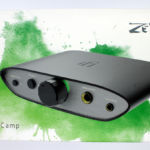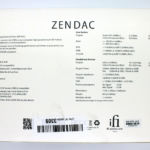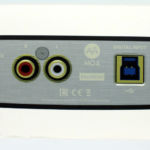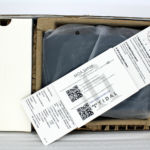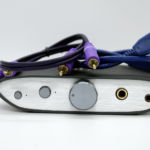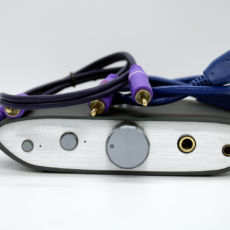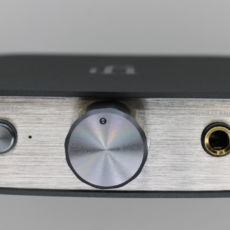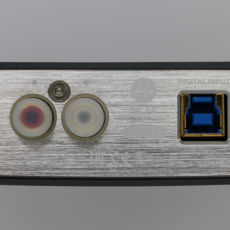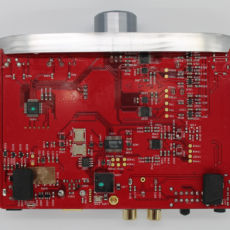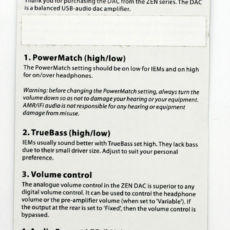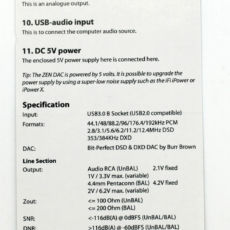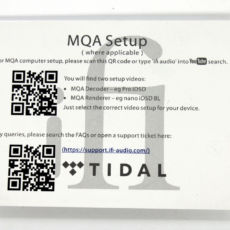ifi Zen DAC
disclaimer: The Zen is a loaner provided by iFi Audio for review and must be returned when the review is complete. I have no financial interest in iFi or its parent AMR. I have previously reviewed the Zen Blue and this is the other model in the Zen line and is a desktop DAC/Amp. A big thanks of iFi-Audio. If you are interested in the Zen series or other iFi products, check their website.
Unboxing / Packaging:
The Zen ships in a lift top style box with the main unit housed in an egg-crate surround with the USB cable and RCA cables in a small box to the right of the unit. An instruction card and warranty card round out the package. While the Zen does have a barrel jack for an external power supply, none is provided so if you wish to power it off something other than USB (which I recommend) you will need to purchase the power supply separately. I think knowing this is a stand alone unit, I would have been inclined to skip the RCA cables and include the power supply if only providing one or the other. I guess those using the Zen to feed powered monitors will disagree here. The cable I most wish was included or at least offered via iFi’s website as an add on is the 4.4 balanced to dual XLR adapters for use with balanced gear. As of this writing, the iFi website does not list any such option. For those interested, I purchased a 4.4 balanced to dual XLR for testing from LQi Cables (I have no affiliation).
Build:
The Zen is well made with an aluminum shell and face-plates. Four screws run the entire depth of the unit and connect the front and rear face-plates making disassembly straight forward if ever required. The board is slotted into the case so has no play in any direction when the screws are tightened down. The front face has two buttons on the left, a large central volume knob with the LED indicator behind it, and two outputs to the right. The outputs are a 6.3mm TRS single-ended output and a 4.4mm TRRS jack for balanced output. The rear face, from left to right, starts with a 4.4mm TRRS balanced line-out connector followed by a fixed/Variable switch, then the RCA connectors, a USB 3.0 input, and a barrel connector for external power supply. It should be noted that the rear 4.4mm TRRS is intended for use as a pre-out and not as a headphone jack. It can be used as a headphone output with the switch in variable position (although with a proper jack on front there is little reason to) but when switched to fixed line-level output it is entirely too loud and will damage your hearing if not your gear.
Internals:
Removing the 4 screws from the rear of the unit will allow the board to be removed via the front without having to remove the volume knob or disconnect the LED as is required to remove the board to the rear of the unit. Once removed the board is a bit empty looking until you flip it as most of the chips are mounted to the underside of the board. USB input is handled by the large Xmos chip at the rear edge of the board (blue/green dot in the photo). This appears to be a 2nd generation XMOS208 series chip and supports inputs up to 384kHz for PCM, DSD256, DXD 384, and MQA. Input is then handed off to the Burr Brown DSD1793 DAC chip immediately above it. It may seem odd to some that I list the bit rates on the USB rather than on the DAC chip but I do so as the USB is the limiting factor here. Still looking at the bottom of the board, the upper right area is the amplifier so after passing the 1793, output goes to that area for further amplification. Note the twin rows of chips in the amp for balanced outputs. Output power is listed as 280mW @ 32Ω or 36mW @ 300Ω for the 6.3mm single ended output and 380mW @ 50Ω or 70mW @ 600Ω via the 4.4mm balanced output.
Controls/Features:
The biggest selling point of the Zen is probably the balanced output at the modest price point, but iFi did pack in a few other features as well. On the front panel, we have power-match and true-bass buttons and on the rear we have fixed/variable output switching. The Front also has an LED partially hiding behind the volume knob that indicates state and file format in use.
The Power-match is a gain switch with settings for low impedance/ high sensitivity in ears, and for higher impedance or Lower sensitivity over-ear models. Most other vendors refer to this same option as a gain switch and it is not uncommon for Amplifiers to support 2 or more levels of gain to allow for better matching of output to headphone type. I will say that with sensitive headphones I found it best to leave this in the lower position as some hiss sneaks in when put into the higher gain mode.
True-bass is one of the more useful bass boost circuits I have heard as it doesn’t try and over-do the boost like so many do and it focuses a bit lower on the spectrum with most all of the effect coming below 200Hz and the biggest bump closer to 100Hz. It lifts the sub-bass about +2dB and will indeed give a bass-light headphone a bit more bass presence without a huge sacrifice in quality in the process. Far too many bass boost circuits turn the low end into a big boomy mess so it is nice to see a design that attempts to boost a bit without doing so. Kudos to iFi for that.
The variable /fixed output switch allows setting the output to fixed line level for use with an external amplifier or to volume adjustable output for use with powered monitors lacking their own volume control mechanism. For this I found it worked quite well when pairing with a couple of pairs of near-field monitors as would be typical for a work desk.
The LED indicator uses iFi’s standard color scheme with green representing PCM from 44-96kHz, yellow for PCM above 96kHz, cyan for DSD 64/128, blue for DSD 256, and magenta for MQA.
Sound
The Zen does a fairly good job of being transparent and not coloring the sound but the first thing that one will notice is that the Zen is slightly laidback and smooth rather than being super detailed and analytical. I don’t see this as a fault in an entry level product, but one needs to know that smoothing is present. The next thing one will notice is noise which is unfortunate. The Zen is extremely dependent on clean USB power, that said, I have yet to find a PC that does an adequate job of supplying clean power. I quickly switched to using an external regulated power supply and found good improvement as the noise was gone and the background became black instead of the previous shade of light gray. Bass has good weight without the boost circuit so unless you are a basshead, you wont need the little button. Vocals are well voiced and mids in general share that same slightly forward presentation. Top end has good air and some sparkle as well. All in all, I enjoyed the presentation with the exception of being slightly too smoothed over for me.
I read about a new firmware that replaced the Linear Phase filter with the GTO filter from the Pro iDSD so decided to load it and see if I could hear a difference. Honestly, I wasn’t expecting much as I have spent countless hours trying to be able to pick out changes made by some of the dac filters and still can’t reliably do so. Well, I was surprised here and suggest if you have or get a Zen – Load this firmware. It definitely cleans up the sound and that smoothness that I previously mentioned was replaced with a much more articulate sound that was both thicker and cleaner if that is even possible. The Zen retains some fluidity with this new firmware but doesn’t sound like someone tried to round off all the sharp edges anymore. Much improved.
The only other thing to mention here is output power which is lacking the grunt to power heavy duty cans like my He6se and even the 600Ω Beyers place enough demand on the Zen that it has less headroom than optimal. I found it best used with 150Ω or lower cans with the HD650 being about the limit of what it can reasonably be expected to push well.
Comparisons
AudioEngine D1 – The D1 represents a previous generation of device with 96kHz limit when used with USB input and a 192kHz limit with Optical input. Still for most this will not be a limit as the vast majority of users will be most 44.1, 48, or 96kHz files anyway. Power is roughly the same between these two units as well. The Zen adds balanced output, and the gain/bass features, but loses optical input. Honestly, if I already had the D1, I’d probably skip getting the Zen unless I just had to have the balanced output. If I were buying today, the Zen is the more versatile option of the two.
Topping DX3 Pro – The DX3 Pro is quite a bit more pricey ($220 vs $129 retail) than the Zen, so we expect more from it, but with topping representing perhaps the best Chi-fi budget option right now, it seems remiss not to do the comparison. The DX3 Pro lacks the balanced output of the Zen but gains dual 4493 DACs that give it an advantage of support 32/768 PCM and DSD512 although it does not have MQA support. Both have dual gain options for different headphones, but the DX3 has considerably higher output power at 700mW@32Ω and 125mW@300Ω. The drawback to the DX3 pro is the 3.5mm jack instead of the larger 6.3 which would make it more compatible with typical full-sized cans. The DX3 also sports bluetooth, optical. and coaxial inputs for those who need them. What this shows is how much $100 extra can buy in today’s market as the DX3 packs a ton of features for a modest price. Still the Zen offers balanced output, and MQA support which the DX3 can’t match.
Thoughts / Conclusion:
Well, I have to admit, the Zen was on its way to being the 1st iFi product that I couldn’t honestly recommend. It has limited output power, limited input options, has a fair amount of noise and even a bit of hiss on high gain, and lacked a bit of detail to the signature that I would have preferred. Based on that, I was going to have to say pass on this one until they do a bit more work, but then two things happened. First they did a bit more work and the new firmware with the GTO replacement for the linear filter is a big improvement. So much for my too smoothed over argument. Then I plugged in a linear power supply and my other major argument about noise went away too. I was left with a good little dac / pre-amp once those two issues are cured. Sure, I’d love for iFi to have included the power supply in the box, and they likely could have if they’d charged me $179 instead of $129 too. One shouldn’t expect miracles from an entry level product and within that framework I can say the Zen does a good job of hitting the marks they were aiming for (with the caveat of loading the new firmware and getting a power supply for it). At this point, the Zen is a guarded recommendation in that it can perform well, but you’ll need to spend on a power supply for it to realize its full potential.
-
Packaging - 6/106/10
-
Accessories - 5/105/10
-
Build Quality - 7.5/107.5/10
-
Sound Quality - 7/107/10
Summary
Pros – balanced output at a very reasonable price, DAC/Pre-amp functionality
Cons – Needs external power supply to perform well, limited output power


